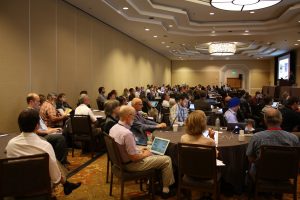19 July 2016
Meeting report: 2016 EarthCube All Hands Meeting
Posted by bbane
This is part of a new series of posts that highlight the importance of Earth and space science data and its contributions to society. Posts in this series showcase data facilities and data scientists; explain how Earth and space science data is collected, managed and used; explore what this data tells us about the planet; and delve into the challenges and issues involved in managing and using data. This series is intended to demystify Earth and space science data, and share how this data shapes our understanding of the world.
By Jamie Ryan
More than 130 geoscientists and cyberinfrastructure researchers beat the early June heat wave in Denver by spending their time planning the next stages of the National Science Foundation’s (NSF) EarthCube e-infrastructure project. Attendees of the third annual All Hands Meeting (AHM) represented major geoscience data facilities, hardware and software developers and scientists interested in the digital tools being developed. This year’s AHM marked an important milestone in the EarthCube project: as it approaches its fourth year, EarthCube cyberinfrastructure is coalescing around a number of common themes regarding the handling and sharing of data in the geosciences.

Members of the EarthCube community gathered in Denver in early July for the EarthCube All Hands Meeting. Credit: Jamie Ryan.
This year’s meeting theme, “EarthCube Connects,” focused on refining an EarthCube architecture, building off the outcomes of workshops held before the AHM in Denver. Funded project representatives provided updates on their progress and products while breakout sessions generated intense discussion on the need for an e-architectural framework. A lively poster session (what scientific conference is complete without one?) featured demonstrations of more than 30 of the products in development. The demonstrations included products aimed at data discovery (GeoLink), web retrieval of data sets (GeoWS), viewing and analyzing real-time data using the cloud (CHORDS), and the incorporation of software code into journal publications (OntoSoft and Geoscience Paper of the Future), among many others.
The meeting boasted four keynote speakers discussing the benefits and potential pitfalls of large-scale cyberinfrastructure projects. Ariel Anbar (“Transdisciplinary Training through Technology,” Arizona State), Harlan Spence (“Lessons in Interdisciplinary Research,” University of New Hampshire), Dan Stanzione (“Architectures for Cyberinfrastructure,“ Texas Advanced Computing Center), and Anne Thessen (“Community-Driven Cyberinfrastructure for Biological Sciences,” Ronin Institute for Independent Scholarship) provided excellent insight to EarthCube opportunities and challenges through their talks and responses to audience questions.
A project with the scale and scope of EarthCube relies heavily on its community for support and growth. This year’s All Hands Meeting provided significant opportunities for members of the community to engage with one another in person, sometimes meeting face to face for the first time with people they’ve worked virtually for months or years.
EarthCube continues to evolve, and will require the expertise and energies of many to reach its full potential. We invite anyone who is interested to review the projects currently in development, receive updates through our newsletters, or to explore deeper using our website, EarthCube.org.
—Jamie Ryan works at the EarthCube Office










 GeoSpace is a blog on Earth and space science, managed by AGU’s Public Information staff. The blog features posts by AGU writers and guest contributors on all sorts of relevant science topics, but with a focus on new research and geo and space sciences-related stories that are currently in the news.
GeoSpace is a blog on Earth and space science, managed by AGU’s Public Information staff. The blog features posts by AGU writers and guest contributors on all sorts of relevant science topics, but with a focus on new research and geo and space sciences-related stories that are currently in the news.